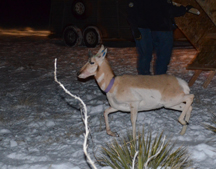 Colorado Parks and Wildlife has announced surveys of bighorn, pronghorn and elk, and Washington State is examining the health of its elk herd.
Colorado Parks and Wildlife has announced surveys of bighorn, pronghorn and elk, and Washington State is examining the health of its elk herd.
A Colorado Division of Wildlife press release describes the bighorn and elk surveys as major research projects. The aim of the elk study is to get a better idea of the population and to find elk migration patterns. The bighorn study will investigate the decline of one of the three populations of sheep in the survey area.
Read the whole press release for more details about the Colorado bighorn and elk study, including survey methods.
The pronghorn study will investigate why fawn survival is so low in a population introduced into western Colorado about 10 years ago, another Division of Wildlife press release says. In related news, on March 1, 74 pronghorns were released to supplement a population in the Gunnison Basin.
Read the pronghorn press release here, for more details, including survey techniques.
Biologists from the Washington Department of Fish and Wildlife are examining elk organs and teeth submitted by hunters to determine the health of the herd, says an article in the Eugene Register-Guard. The teeth were used to determine the age of each animal. The organs are examined for fat, the article says. There’s a formula that converts the amount of fat observed on the organs to a percentage of fat on-the-hoof.
The fatter the better, since fat reserves are needed to get through the winter.
Photo: A pronghorn antelope is release March 1, 2012, by Colorado Parks and Wildlife. The pronghorn was captured in Limon earlier in the day and released near Delta to supplement a small herd in that area. Photo: Colorado Parks and Wildlife
